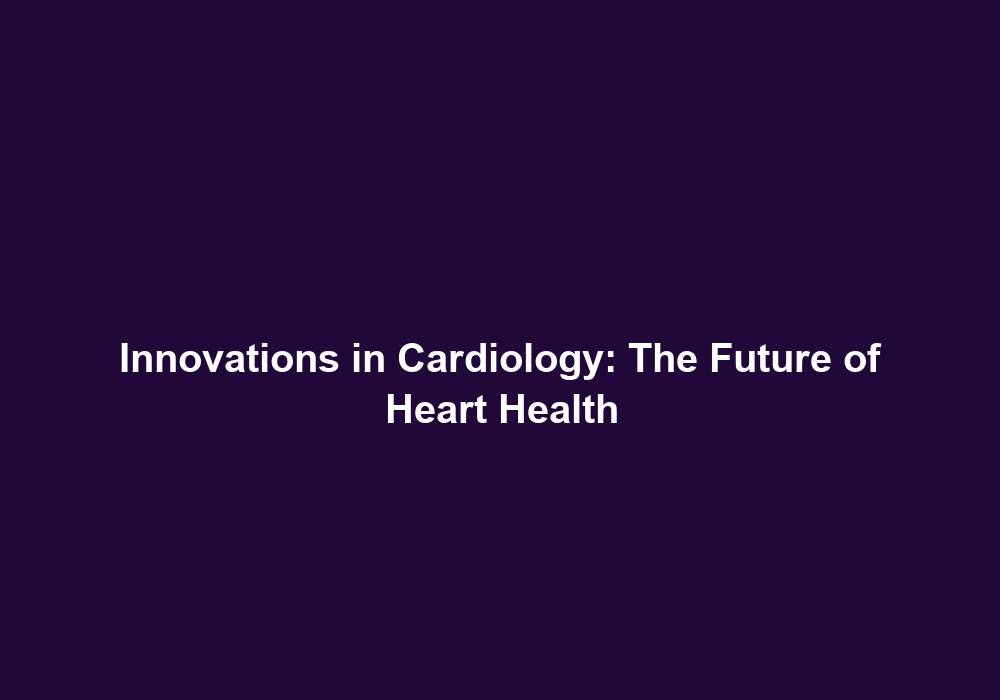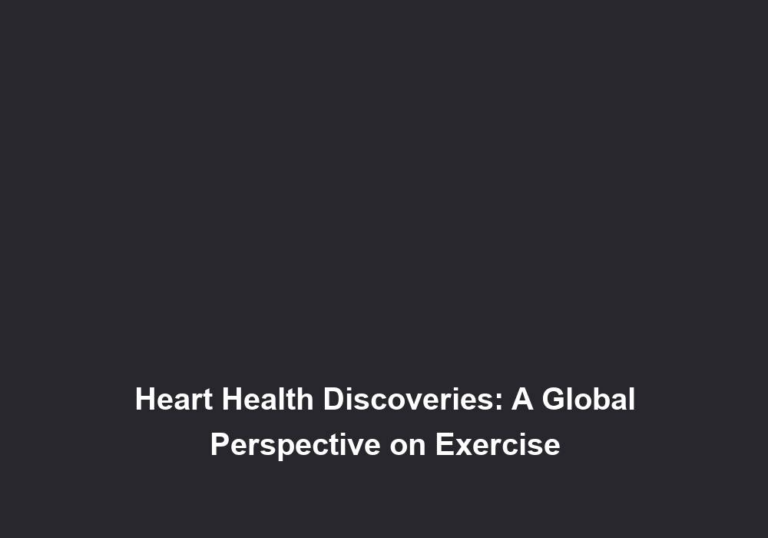Innovations in Cardiology: The Future of Heart Health
The field of cardiology has witnessed remarkable advancements that have revolutionized the way we understand, diagnose, and treat heart-related diseases. With continuous technological advancements, innovative approaches, and groundbreaking research, the future of heart health looks promising. In this article, we will delve into some of the most exciting innovations in cardiology that hold immense potential in improving patient outcomes and transforming the landscape of cardiovascular care.
1. Precision Medicine: Personalized Approach to Cardiac Care
Precision medicine has emerged as a game-changer in the field of cardiology. It focuses on tailoring medical treatment and interventions based on an individual’s unique genetic makeup, lifestyle, and environmental factors. By analyzing a patient’s genetic information, healthcare providers can predict their susceptibility to certain cardiovascular conditions and develop personalized prevention and treatment strategies.
Advancements in genomic sequencing technologies have made it possible to identify specific genetic markers associated with cardiovascular diseases. This allows healthcare providers to determine an individual’s risk factors and develop personalized prevention plans. For example, if a patient is found to have a genetic predisposition to high cholesterol levels, lifestyle modifications and targeted medications can be prescribed to manage the condition effectively.
In addition to genetic information, precision medicine takes into account lifestyle and environmental factors. By considering a patient’s diet, exercise habits, and exposure to pollutants, healthcare providers can offer personalized recommendations to reduce the risk of heart disease. This holistic approach to cardiac care ensures that patients receive the most effective and tailored treatments, leading to improved patient outcomes.
2. Artificial Intelligence and Machine Learning
Artificial Intelligence (AI) and machine learning have become indispensable tools in cardiology research and clinical practice. These technologies have the ability to analyze vast amounts of data and identify patterns that might be missed by human experts. AI algorithms can help in early detection of heart diseases, risk stratification, and treatment planning. Additionally, machine learning algorithms can aid in the interpretation of complex cardiac imaging, such as echocardiograms and cardiac MRI scans, enabling faster and more accurate diagnosis.
AI-powered algorithms can analyze patient data, including medical history, lab results, and imaging studies, to identify patterns and predict the risk of developing cardiovascular diseases. This early detection allows for timely intervention and prevention strategies. For example, AI algorithms can identify subtle changes in electrocardiogram (ECG) readings that indicate an increased risk of developing arrhythmias or other heart conditions. This information can prompt healthcare providers to initiate appropriate interventions, such as medication adjustments or lifestyle modifications.
Machine learning algorithms also play a crucial role in improving the accuracy and efficiency of cardiac imaging interpretation. By training algorithms on large datasets of annotated images, these algorithms can learn to recognize specific cardiac features and abnormalities. This enables faster and more accurate diagnosis, leading to improved patient outcomes. For instance, AI algorithms can assist in the detection of coronary artery disease by analyzing cardiac CT scans and identifying calcifications or blockages in the arteries.
3. Wearable Devices and Remote Monitoring
Wearable devices, such as smartwatches and fitness trackers, have gained significant popularity in recent years. These devices are equipped with sensors that can monitor various physiological parameters, including heart rate, blood pressure, and sleep patterns. By continuously monitoring these parameters, individuals can proactively manage their heart health and detect any anomalies at an early stage. Remote monitoring systems, coupled with wearable devices, allow healthcare providers to remotely monitor patients’ cardiac health and intervene promptly if necessary, reducing hospital visits and improving overall patient care.
Wearable devices offer individuals the convenience of monitoring their heart health in real-time. By tracking heart rate, individuals can identify abnormal heart rhythms, such as atrial fibrillation, and seek medical attention promptly. These devices also provide data on physical activity levels, allowing users to monitor their exercise habits and make necessary adjustments for a healthier heart.
For healthcare providers, remote monitoring systems offer a way to continuously track patients’ cardiac health without the need for frequent in-person visits. Patients can transmit their data to healthcare providers through secure online platforms, allowing for timely interventions when abnormalities are detected. This remote monitoring approach reduces the burden on healthcare systems and improves patient outcomes by enabling early detection and intervention.
4. Transcatheter Interventions
Transcatheter interventions have revolutionized the field of interventional cardiology. They involve minimally invasive procedures performed through a catheter, eliminating the need for open-heart surgery. Transcatheter interventions, such as transcatheter aortic valve replacement (TAVR) and percutaneous coronary interventions (PCI), have improved outcomes for patients with valvular heart diseases and coronary artery diseases, respectively. These procedures offer shorter recovery times, reduced postoperative complications, and better quality of life compared to traditional surgical approaches.
Transcatheter interventions have transformed the treatment landscape for patients with valvular heart diseases. In the past, open-heart surgery was the primary option for replacing a diseased heart valve. However, transcatheter aortic valve replacement (TAVR) offers a less invasive alternative. During the TAVR procedure, a new valve is inserted through a small incision in the groin or chest and guided to the heart using a catheter. This approach reduces the risk of complications and allows for faster recovery and improved quality of life.
Percutaneous coronary interventions (PCI), such as angioplasty and stenting, have also benefited from transcatheter techniques. Instead of undergoing traditional open-heart surgery to treat coronary artery disease, patients can now undergo minimally invasive procedures. During PCI, a catheter is used to access the blocked or narrowed coronary artery, and a balloon is inflated to widen the artery. A stent is then placed to keep the artery open, restoring blood flow to the heart. This approach reduces the risk of complications, shortens hospital stays, and improves patient outcomes.
5. Regenerative Medicine and Stem Cell Therapy
Regenerative medicine holds great promise in the field of cardiology. Researchers are exploring the potential of stem cell therapy to repair damaged heart tissues and improve cardiac function. Stem cells can differentiate into various cell types, including cardiomyocytes, which are the building blocks of the heart muscle. This approach aims to regenerate and restore the damaged cardiac tissues, potentially reducing the need for heart transplants and offering new hope for patients with heart failure.
Stem cell therapy offers a potential solution for patients with heart failure, a condition characterized by the loss of functional heart muscle cells. By introducing stem cells into the damaged heart tissue, researchers hope to stimulate the regeneration of new, healthy heart muscle cells. This could potentially improve cardiac function, reduce symptoms, and enhance the quality of life for patients with heart failure.
Different types of stem cells are being investigated for their regenerative potential in cardiology. For example, induced pluripotent stem cells (iPSCs) can be generated from a patient’s own skin cells and then coaxed to differentiate into cardiomyocytes. These iPSC-derived cardiomyocytes can be transplanted back into the patient’s heart to replace damaged tissue. Researchers are also exploring the use of mesenchymal stem cells (MSCs) derived from bone marrow or umbilical cord tissue, which have shown promising regenerative effects in preclinical and clinical studies.
6. Telemedicine and Virtual Care
Telemedicine and virtual care have gained significant traction, particularly in the wake of the COVID-19 pandemic. These technologies allow patients to remotely consult with healthcare providers, enabling timely access to cardiac care without the need for in-person visits. Telemedicine not only improves patient convenience but also facilitates early intervention and continuous monitoring, improving patient outcomes and reducing the burden on healthcare systems.
Telemedicine offers a convenient and efficient way for patients to seek medical advice and treatment for their cardiac conditions. Through video consultations, patients can discuss their symptoms, receive medical advice, and even undergo remote examinations, such as listening to heart sounds with the help of a digital stethoscope. This eliminates the need for patients to travel long distances or wait for appointments, ensuring timely access to cardiac care.
For healthcare providers, telemedicine allows for early intervention and continuous monitoring of patients with cardiac conditions. By remotely monitoring patients’ vital signs, such as blood pressure and heart rate, healthcare providers can detect any abnormalities and intervene promptly. This proactive approach reduces the risk of complications and improves patient outcomes. Telemedicine also enables healthcare providers to manage chronic conditions more effectively by regularly assessing symptoms and adjusting treatment plans as needed.
7. Advanced Imaging Techniques
Advancements in imaging techniques have revolutionized the diagnosis and treatment of cardiovascular diseases. Techniques such as 3D echocardiography, cardiac MRI, and computed tomography angiography (CTA) provide detailed anatomical and functional information about the heart, enabling accurate diagnosis and treatment planning. These imaging modalities offer enhanced visualization, improved spatial resolution, and reduced radiation exposure, making them invaluable tools in the field of cardiology.
3D echocardiography allows for a comprehensive assessment of cardiac structures and function. By capturing multiple images from different angles, this technique creates a detailed 3D model of the heart, enabling precise measurements and visualization of abnormalities. This information is crucial for accurate diagnosis and treatment planning, particularly in complex cases such as congenital heart diseases or valve disorders.
Cardiac MRI provides detailed images of the heart and its blood vessels, allowing for the assessment of cardiac anatomy, function, and blood flow. This non-invasive technique offers excellent soft tissue contrast and can detect subtle abnormalities that may not be visible on other imaging modalities. Cardiac MRI is particularly useful for evaluating myocardial viability, assessing scar tissue after a heart attack, and diagnosing cardiomyopathies.
Computed tomography angiography (CTA) is a non-invasive imaging technique that uses X-rays and computer algorithms to create detailed images of the heart and its blood vessels. CTA can detect blockages or narrowing in the coronary arteries, helping to diagnose coronary artery disease. This technique offers high spatial resolution and fast image acquisition, reducing the need for invasive diagnostic procedures such as cardiac catheterization.
8. Genomic Medicine and Gene Therapy
Genomic medicine aims to utilize genetic information to prevent, diagnose, and treat diseases, including those related to the heart. The identification of genetic markers associated with inherited cardiac conditions has led to improved screening and targeted interventions for at-risk individuals. Furthermore, gene therapy holds promise in correcting genetic defects responsible for certain cardiovascular diseases, potentially offering a cure rather than just symptom management.
Genetic testing has become an integral part of cardiovascular care, especially for individuals with a family history of heart disease. By analyzing an individual’s DNA, healthcare providers can identify genetic variants associated with inherited cardiac conditions, such as hypertrophic cardiomyopathy or long QT syndrome. This information allows for targeted screening of at-risk family members and the initiation of preventive measures, such as medication or lifestyle modifications.
Gene therapy offers a potential cure for certain cardiovascular diseases caused by specific genetic mutations. This approach involves introducing healthy copies of the mutated gene into the patient’s cells to restore normal function. For example, gene therapy has shown promising results in the treatment of inherited high cholesterol disorders by targeting the gene responsible for cholesterol metabolism. By correcting the underlying genetic defect, gene therapy offers the possibility of long-term disease management and improved patient outcomes.
In conclusion, the future of heart health is filled with exciting innovations in cardiology. From precision medicine and artificial intelligence to wearable devices and regenerative medicine, these advancements hold tremendous potential in improving patient outcomes, enhancing early detection, and transforming the way we approach cardiovascular care. With continued research and collaboration, these innovations will undoubtedly pave the way for a healthier future, reducing the burden of heart disease and improving the quality of life for individuals worldwide.







